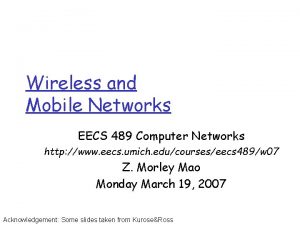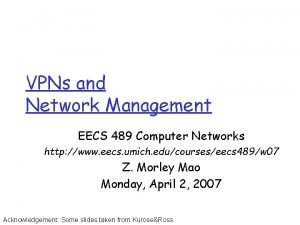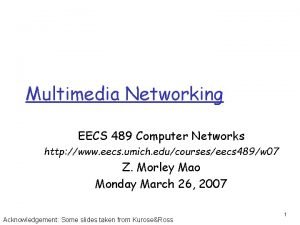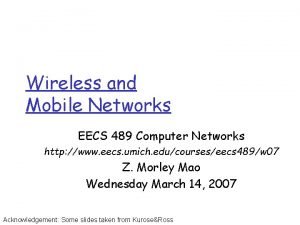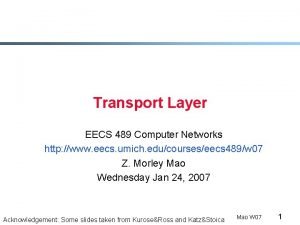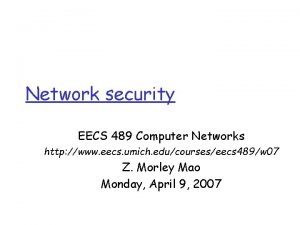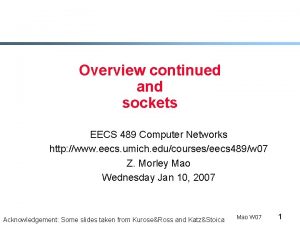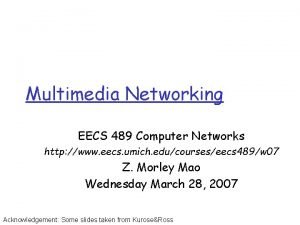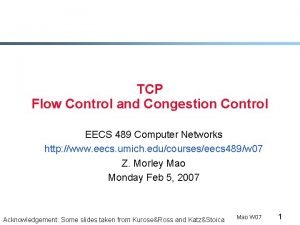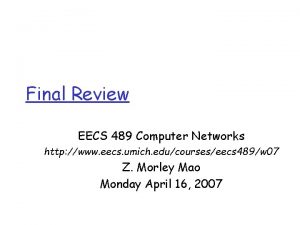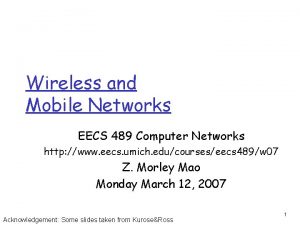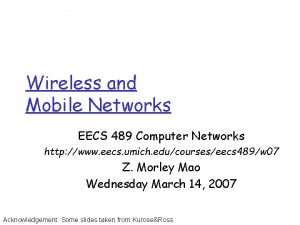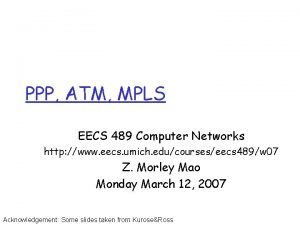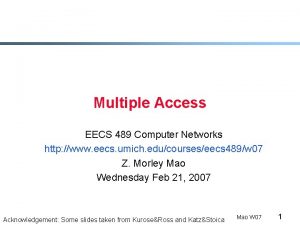Midterm Review EECS 489 Computer Networks http www















- Slides: 15

Midterm Review EECS 489 Computer Networks http: //www. eecs. umich. edu/courses/eecs 489/w 07 Z. Morley Mao Monday Feb 19, 2007 Acknowledgement: Some slides taken from Kurose&Ross and Katz&Stoica Mao W 07 1

Adminstrivia § Homework 2 - Problems from the book - You can either use Turnin program or turn in the homework on paper to my office. - Due date: tomorrow -- 2/20 § Midterm 1 is in class on Wednesday March 7 th - Please let us know if you prefer to take it early - Material: Chapter 1 -4 - You can have one sheet of notes for the midterm. Mao W 07 2

Internet protocol stack § application: supporting network applications - FTP, SMTP, HTTP § transport: host-host data transfer - TCP, UDP § network: routing of datagrams from source to destination - IP, routing protocols § link: data transfer between neighboring network elements application transport network link physical - PPP, Ethernet § physical: bits “on the wire” Mao W 07 3

Think at two levels § Protocols (Details of protocols may change!) - HTTP, SMTP, FTP, DNS, RTP, RTCP, RSVP, SNMP, SIP, H 323, Mobile. IP - UDP, TCP, ICMP - BGP, RIP, OSPF, (link-state, distance-vector, path-vector) - IP, ARP - CSMA/CD (CA), MPLS, CDMA, FDMA § Principles/concepts (fundamental to network design) - Packet switching, congestion control, flow control, - Caching/replication, layering (level of indirection), multiplexing - Hierarchical structure, signaling, pipelining, error coding - End to end principle, virtualization, randomization Mao W 07 4

Topics of importance § Project assignments: PA 1 - Socket programming, blocking and non-blocking I/O - Server programming § § Packet switching vs. circuit switching Router architectures - Queue management § TCP - Congestion control, flow control § Routing protocols - Interdomain and intradomain routing Mao W 07 5

Timing of Datagram Packet Switching Host 1 transmission time of Packet 1 at Host 1 Node 1 Packet 1 propagation delay between Host 1 and Node 2 Packet 3 Host 2 Node 2 Packet 1 processing delay of Packet 1 at Node 2 Packet 3 Packet 1 Packet 2 Packet 3 Mao W 07 6

TCP: Implementing AIMD § After each ACK - increment cwnd by 1/cwnd (cwnd += 1/cwnd) - as a result, cwnd is increased by one only if all segments in a cwnd have been acknowledged § But need to decide when to leave slow-start and enter AIMD § use ssthresh variable Mao W 07 7

Slow Start/AIMD Pseudocode Initially: cwnd = 1; ssthresh = infinite; New ack received: if (cwnd < ssthresh) /* Slow Start*/ cwnd = cwnd + 1; else /* Congestion Avoidance */ cwnd = cwnd + 1/cwnd; Timeout: /* Multiplicative decrease */ ssthresh = cwnd/2; cwnd = 1; Mao W 07 8

The big picture (with timeouts) cwnd Timeout AIMD ssthresh Slow Start Time Mao W 07 9

Congestion Detection Revisited § Wait for Retransmission Time Out (RTO) - RTO kills throughput § In BSD TCP implementations, RTO is usually more than 500 ms - the granularity of RTT estimate is 500 ms - retransmission timeout is RTT + 4 * mean_deviation § Solution: Don’t wait for RTO to expire Mao W 07 10

Fast Retransmits § Resend a segment after 3 duplicate ACKs - a duplicate ACK means that an out-of sequence segment was received ACK 2 cwnd = 2 segment 3 ACK 3 cwnd = 4 § segment 1 cwnd = 1 ACK 4 Notes: - ACKs are for next expected packet - packet reordering can cause duplicate ACKs - window may be too small to get enough duplicate ACKs 3 duplicate ACKs ACK 4 segment 5 segment 6 segment 7 ACK 4 Mao W 07 11

Fast Retransmit § Time-out period often relatively long: - long delay before resending lost packet § Detect lost segments via duplicate ACKs. - Sender often sends many segments backto-back - If segment is lost, there will likely be many duplicate ACKs. § If sender receives 3 ACKs for the same data, it supposes that segment after ACKed data was lost: - fast retransmit: resend segment before timer expires Mao W 07 12

Fast Recovery: After a Fast Retransmit § § ssthresh = cwnd / 2 cwnd = ssthresh - instead of setting cwnd to 1, cut cwnd in half (multiplicative decrease) § for each dup ack arrival - dupack++ - Max. Window = min(cwnd + dupack, Adv. Win) - indicates packet left network, so we may be able to send more § receive ack for new data (beyond initial dup ack) - dupack = 0 - exit fast recovery § But when RTO expires still do cwnd = 1 Mao W 07 13

Fast Retransmit and Fast Recovery cwnd AI/MD Slow Start Fast retransmit § Retransmit after 3 duplicated acks Time - Prevent expensive timeouts § § Reduce slow starts At steady state, cwnd oscillates around the optimal window size Mao W 07 14

TCP Congestion Control Summary § Measure available bandwidth - slow start: fast, hard on network - AIMD: slow, gentle on network § Detecting congestion - timeout based on RTT • robust, causes low throughput - Fast Retransmit: avoids timeouts when few packets lost • can be fooled, maintains high throughput § Recovering from loss - Fast recovery: don’t set cwnd=1 with fast retransmits Mao W 07 15
